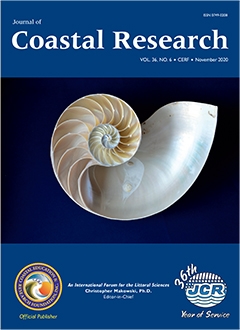Ren, J.; Chen, B.; Li, Y.; Dai, J., and Men, L., 2020. Dynamic variation characteristics of the riparian zone temperature distribution under fluctuating water levels: Field experiments and numerical modeling. Journal of Coastal Research, 36(6), 1178–1196. Coconut Creek (Florida), ISSN 0749-0208.
Understanding the variations in water and heat transfer along the riparian zone under water-level fluctuations is essential for river water management, groundwater extraction, and ecosystem sustainability. The main purpose of this study is to describe the dynamics of the temperature field of the Dongting Lake beach under the fluctuation in the water level and to quantify its main influencing factors. Taking the section of Dongting Lake beach as the research object, an in situ monitoring device was used to monitor the water level, water temperature, and temperature at different depths of the beach in real time for 55 days, and the hydrothermal coupling model of the Dongting Lake beach was calibrated and verified. The main factors affecting the temperature field of the beach were determined by the global sensitivity analysis method. The results show that the fluctuation in the continental beach temperature field is small in the horizontal direction, the stratification phenomenon is obvious in the vertical direction, the temperature gradually rises with increasing depth, and the daily changes are weakened. During the high water level, the deep temperature of the beach has no obvious gradient change in the vertical direction, and as the water level of the river decreases, the external environmental temperature has a greater influence on the internal temperature field of the beach, resulting in a relatively pronounced gradient change in the deep temperature at the low water level. The results of the Morris one at a time global sensitivity analysis show that the permeability coefficient (Ks) has the greatest influence on the sensitivity of the model, followed by the porosity (n) and soil thermal conductivity (λs). The saturated moisture content (θs), residual moisture content (θr), and soil-specific heat capacity (Cs) have no significant effect on the model.





